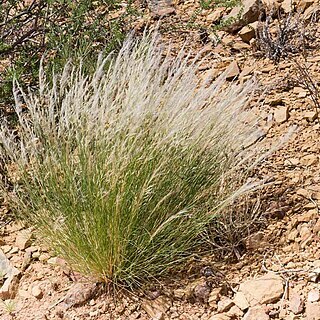Densely to laxly tufted perennial to subperennial, up to 900 mm high. Leaf blade up to 200 x 2 mm, setaceous; ligule a fringe of hairs. Inflorescence a narrow or effuse panicle; spikelets many. Spikelets 8-15 mm long (excluding awn), disarticulating above glumes; glumes glabrous. Floret 1; lemma indurated, articulation between apex of lemma and base of column; awns 3, only central awn plumose with hairs occurring up to 1/3 above or down to branching point of awns, apex without hairs, column well developed; callus 0.5-1.2 mm long, with short hairs along entire length and long hairs at junction of lemma; callus has a pungent, naked point. Flowering time Dec.-May.
Lemma 2-3 mm. long, cylindric, slightly 2-lobed at the apex, glabrous, slightly tuberculate towards the apex; callus 1 mm. long, acute, densely barbate; column c. 5 mm. long, with a dense penicil at the apex, otherwise glabrous; the central awn up to 2.5 cm. long, usually naked in the wer 1/3 and plumose towards the apex, or plumose to the base; lateral awns up to 12 mm. long, glabrous, capillary.
Panicle usually long-exserted, narrow, contracted or effuse; axis terete in the lower part, angular and scaberulous in the upper; branches capillary, nearly glabrous, spreading or suberect, usually solitary but branched near the base.
Glumes unequal, papery, glabrous or with a few hairs on the margins; the inferior 8-9 mm. long, nearly 3-nerved; the superior 9-11 mm. long, conspicuously nerved.
Leaf-laminae up to 15 cm. long, convolute, setaceous, curved or flexuous, scaberulous above and with a few long hairs towards the ligule, glabrous beneath.
A herb. It is a grass that forms tufts. It can be an annual or keep growing for a few years. It grows 90 cm high.
Culms erect, slender, simple or branched in the upper part, smooth or scaberulous, 3-4-noded, nodes glabrous.
Leaf-sheaths glabrous; the lower ones reduced to scales, the upper tight, striate.
Perennial or subperennial, up to 75 cm. or more high, usually densely caespitose.
Ligule a short-ciliate rim; auricles densely long-barbate; collar glabrous.
Caespitose perennial up to about 60 cm. high.
Spikelets yellowish or tinged with purple.

